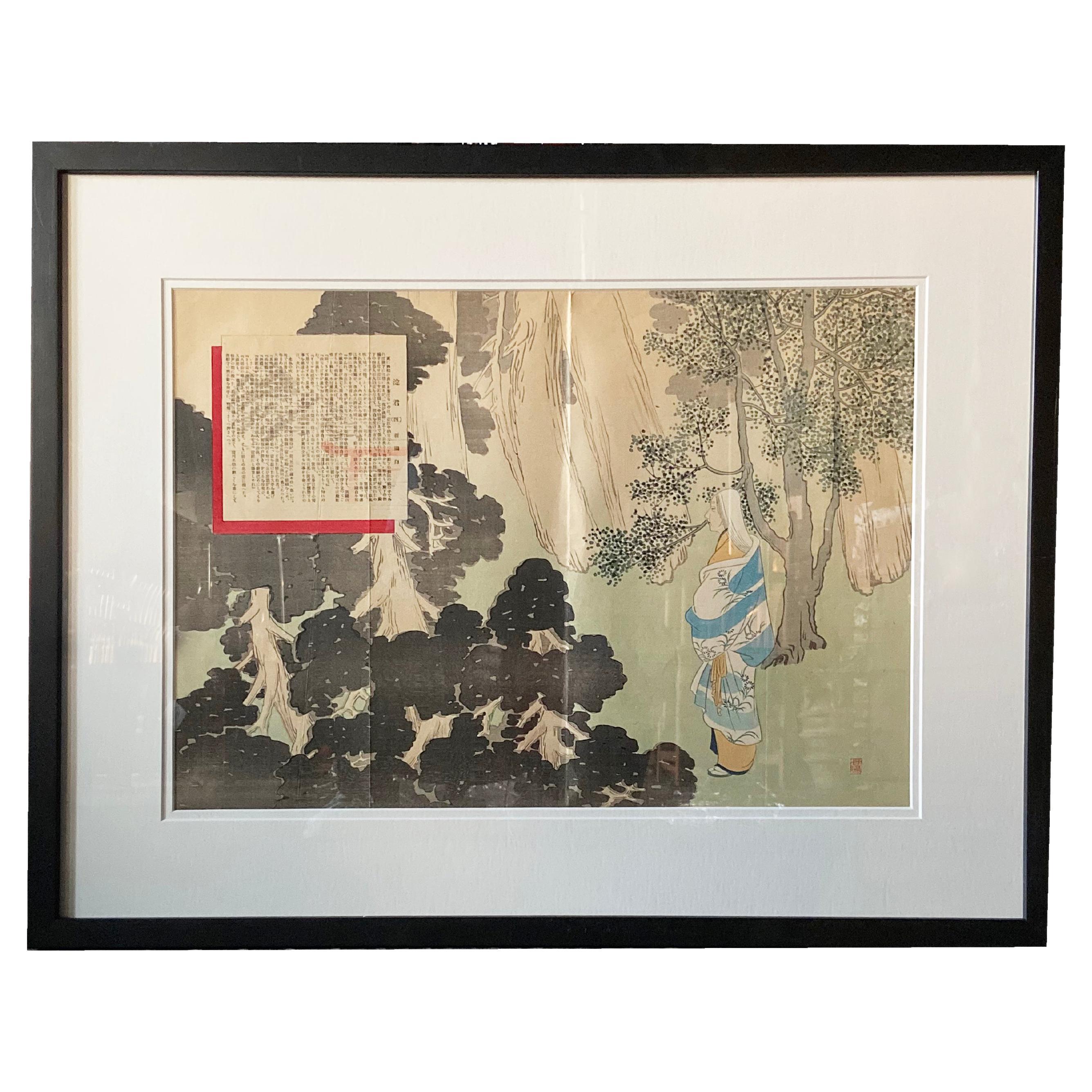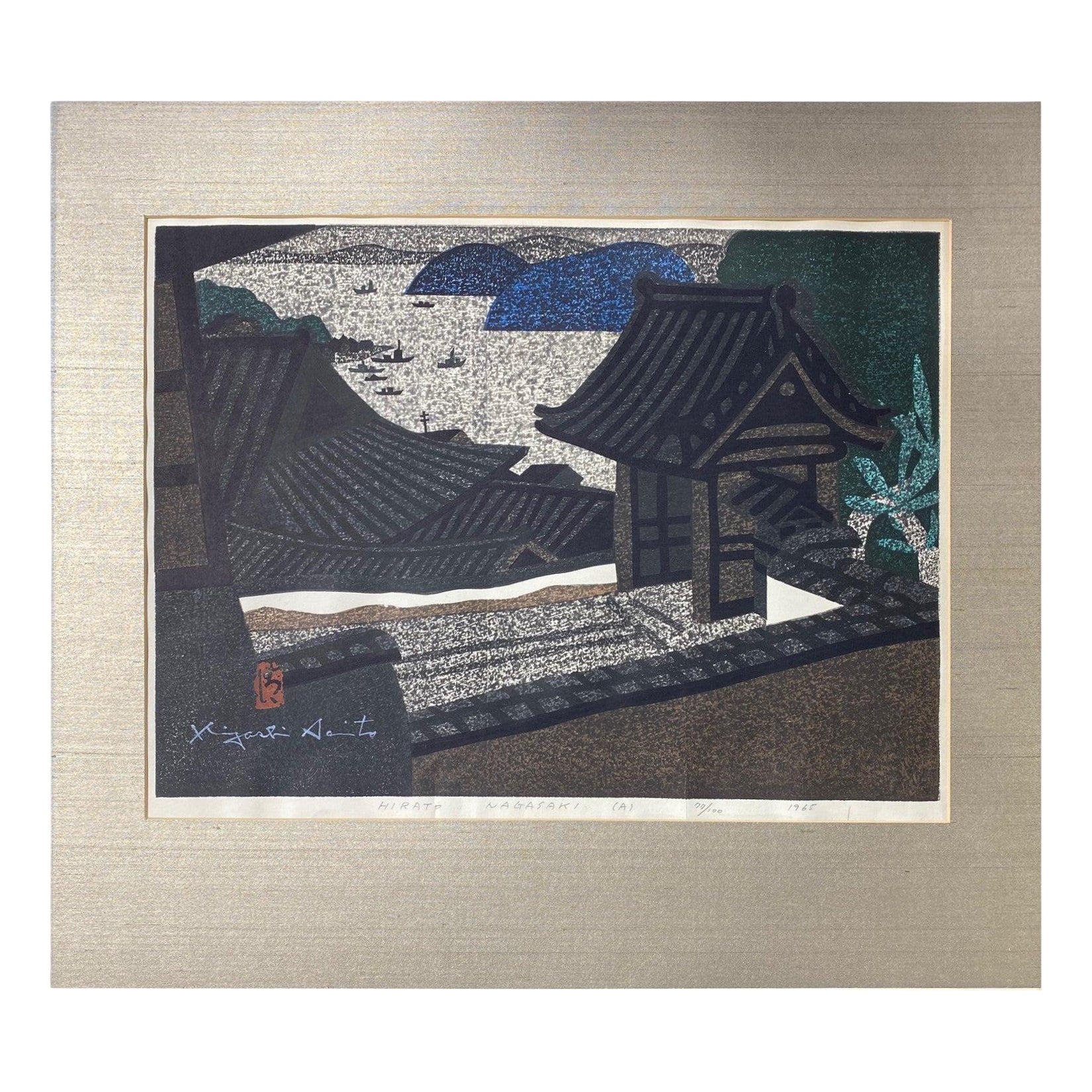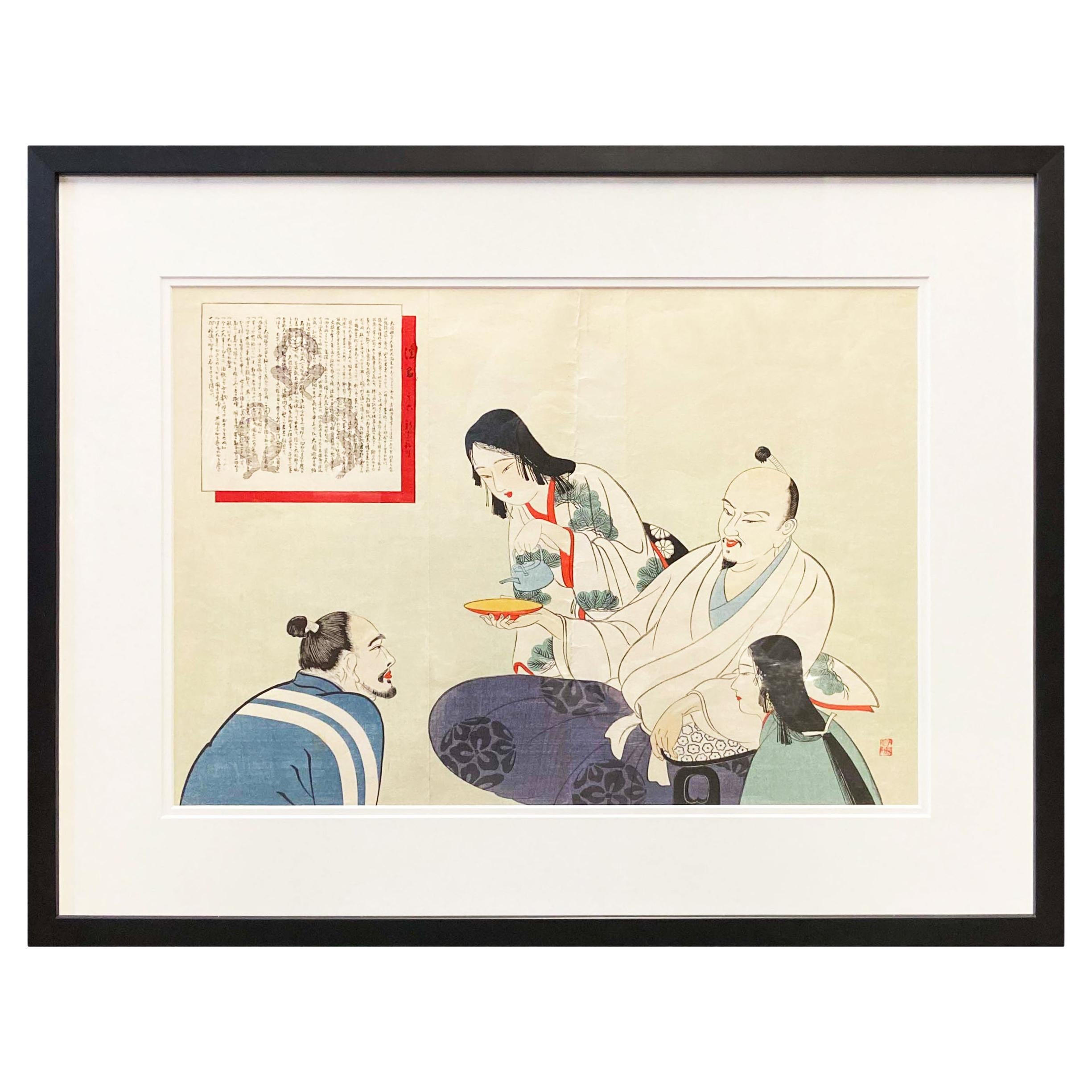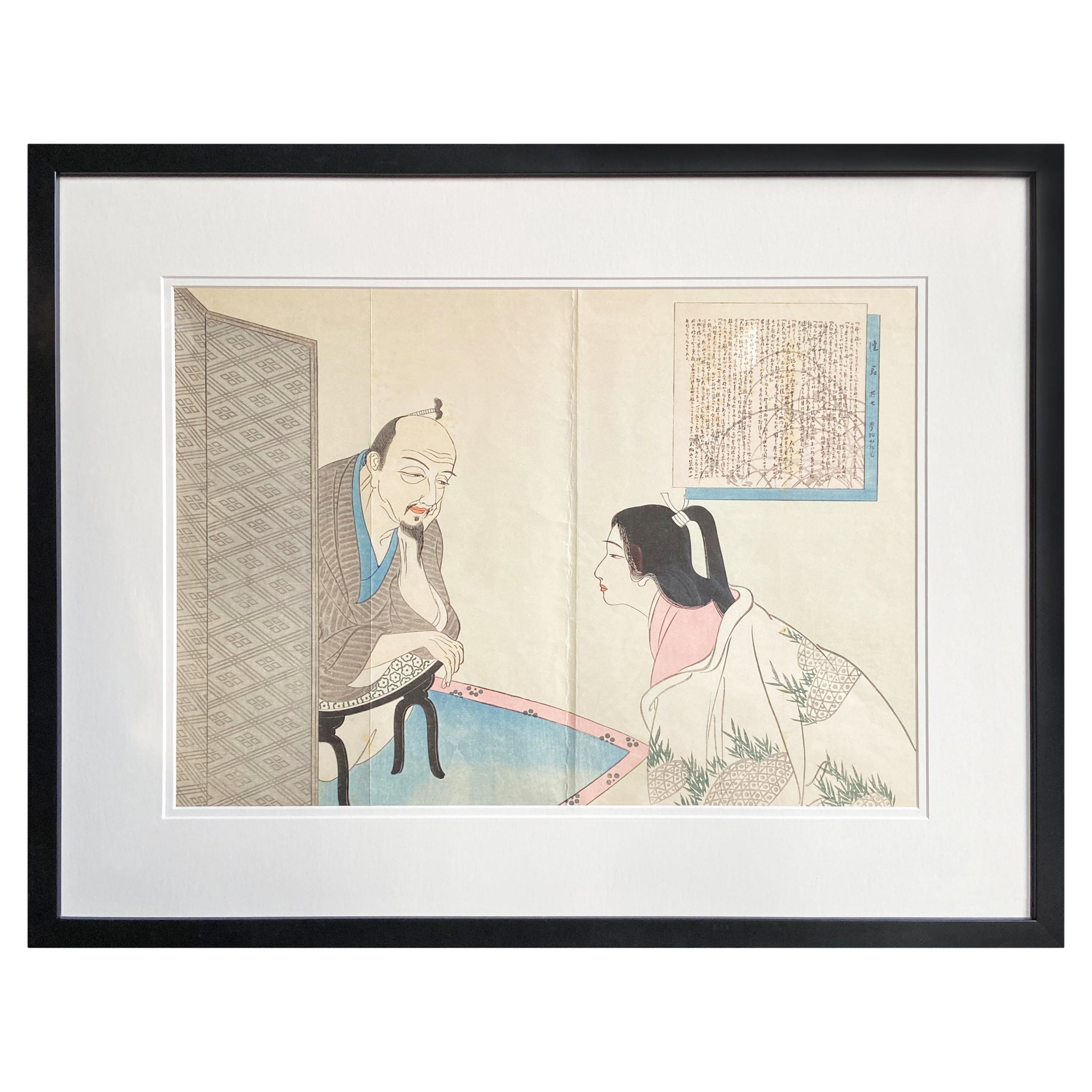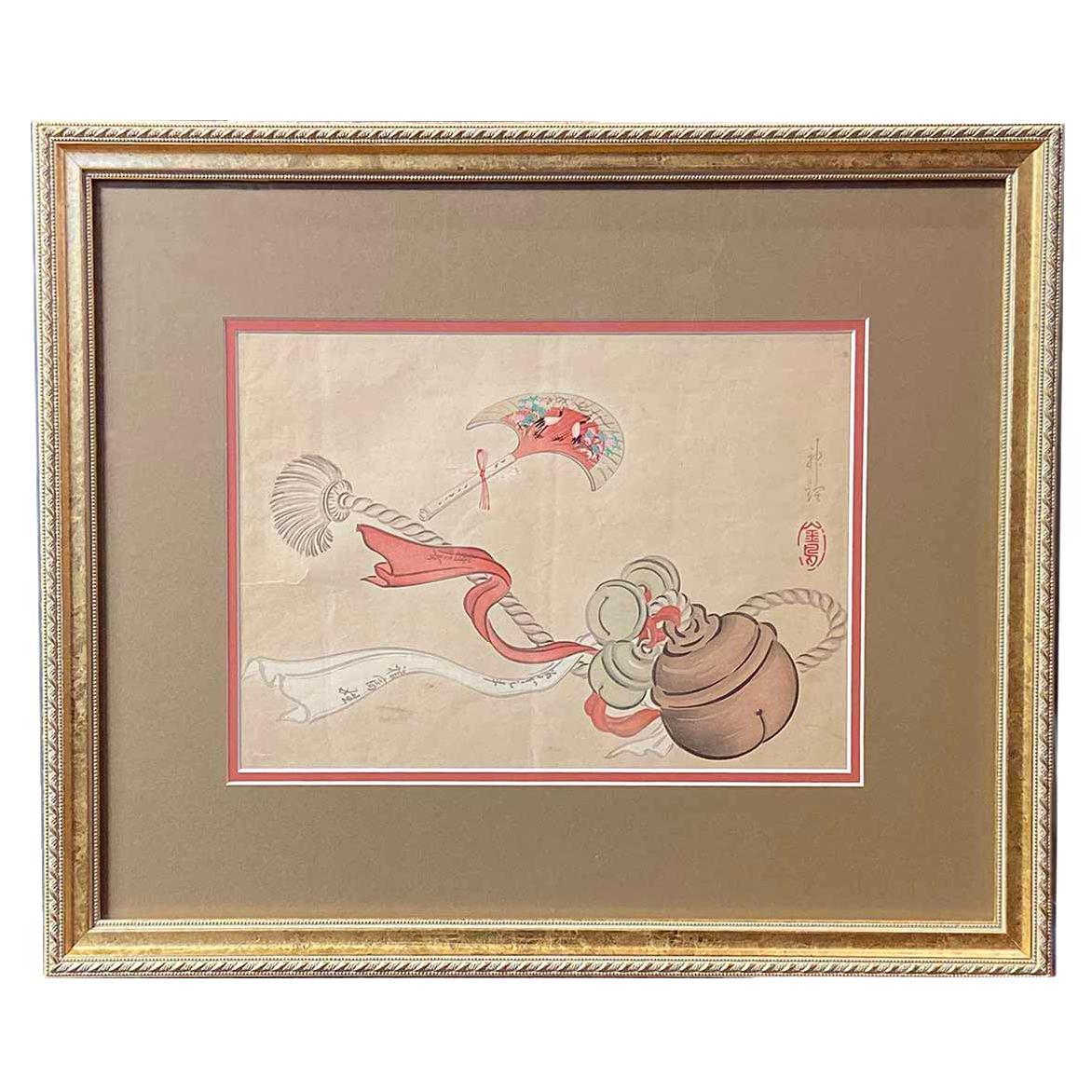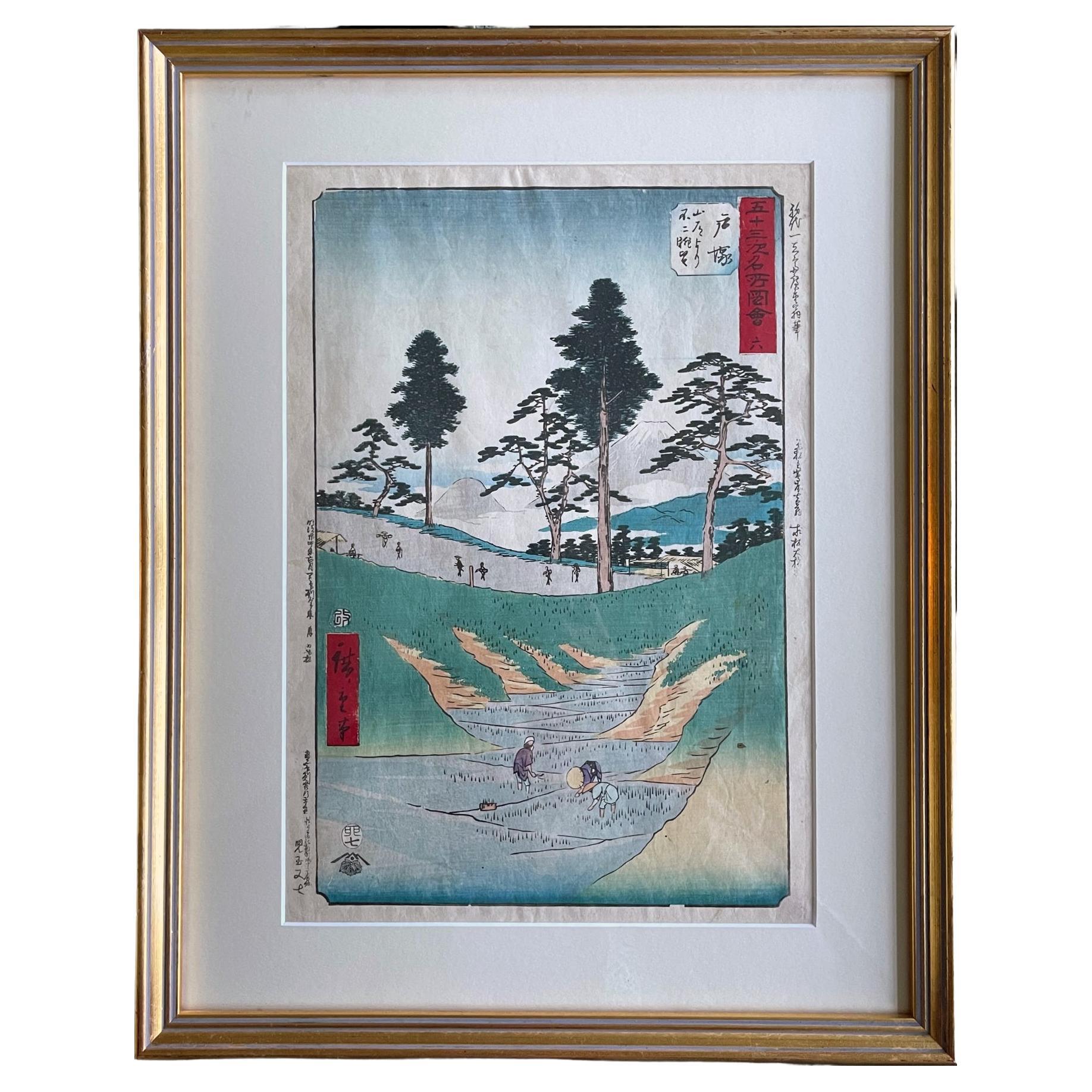Items Similar to A Japanese Nagasaki-e print depicting the arrival of Dutch ships in Nagasaki
Want more images or videos?
Request additional images or videos from the seller
1 of 2
A Japanese Nagasaki-e print depicting the arrival of Dutch ships in Nagasaki
About the Item
Published by Bunkindõ han, circa 1801
Colour woodblock print, H. 32.5 x W. 48 cm
Under this view of Nagasaki Bay, the text states that the first Dutch ships arrived in Nagasaki in 1641. Afterwards, they came annually at the end of June and left on 20 September. The distance to Holland is 13.000 miles. Next, the text gives all the dimensions of the ships.
- Dimensions:Height: 12.8 in (32.5 cm)Width: 18.9 in (48 cm)Depth: 0.4 in (1 cm)
- Materials and Techniques:
- Place of Origin:
- Period:
- Date of Manufacture:Circa 1801
- Condition:Wear consistent with age and use.
- Seller Location:Amsterdam, NL
- Reference Number:1stDibs: LU5458237909152
About the Seller
5.0
Vetted Seller
These experienced sellers undergo a comprehensive evaluation by our team of in-house experts.
Established in 1985
1stDibs seller since 2020
19 sales on 1stDibs
Typical response time: 3 hours
- ShippingRetrieving quote...Ships From: Amsterdam, Netherlands
- Return PolicyA return for this item may be initiated within 7 days of delivery.
More From This SellerView All
- Japanese Nagasaki Export Lacquer Box with Depiction of the 'Trippenhuis'Located in Amsterdam, NLA Japanese Nagasaki export lacquer box with mother-of-pearl depiction of the Amsterdam ‘Trippenhuis’ Edo-period, circa 1830 H. 12.5 x W. 24 x D. 15 cm ? The house depicted on t...Category
Antique 19th Century Japanese Edo Lacquer
MaterialsMother-of-Pearl, Lacquer
- 'Two Dutch Ships Anchored in the Bay of Nagasaki' by Kawahara Keiga '1786-1860'Located in Amsterdam, NLKawahara Keiga (1786 - c. 1860) Two Dutch ships anchored in the bay of Nagasaki Sumi ink and pigment on silk, H. 27 x W. 41 cm (excl. frame) Comes framed, see image. ?Based o...Category
Antique Early 19th Century Japanese Paintings and Screens
MaterialsSilk
- Japanese Export Nagasaki Lacquer Box with the Portrait of Napoleon BonaparteLocated in Amsterdam, NLA Japanese export Nagasaki lacquer tobacco box with the portrait of Napoleon Bonaparte Edo-period, circa 1810 The box in black lacquer on copper, ...Category
Antique 19th Century Japanese Edo Lacquer
MaterialsCopper, Gold
- 17th Century Japanese Export Lacquer Cabinet with Depiction the Dutch TradepostLocated in Amsterdam, NLA highly important Japanese export lacquer cabinet with depiction of the Dutch East India Company tradepost Deshima and the annual Dutch delegation on its way to the Shogun in Edo Edo period, circa 1660-1680 H. 88 x W. 100.5 x D. 54 cm This cabinet includes a later European japanned stand, but also a modern powder-coated steel frame. The latter can be designed and added to your specific needs. The sides and front of the rectangular two-door cabinet are embellished in gold and silver hiramaki-e and takamaki-e on a black roiro lacquer ground with a continuous design. The two doors depict a long procession of numerous figures travelling on foot and horseback along buildings and a pagoda into a mountainous landscape. This is the annual court journey, Hofreis, of the Dutch from Nagasaki to the Shogun’s court in Edo. Three horseback riders are dressed as Dutch merchants and a fourth figure, probably het Opperhoofd, is seen inside a palanquin, norimon. Just about to cross the bridge, two men are carrying a cabinet like the present one. Many Japanese figures on either side of the procession are engaged in various activities; some play musical instruments on board of small boats, others are fishing; figures inside buildings are depicted playing go, and farmers are tending to their rice paddocks. The upper part of the right door shows a large mansion, probably the local daimyo’s castle, with men kneeling before a man in the central courtyard. The court journey fits in with the foreign policy of the shogunate which accorded a role to the VOC alongside China, Korea, and the Ryukyu Islands who also had to pay tribute. However, the VOC employees were traders, having low status in Japan’s social hierarchy, and they were received with less deference than were the state embassies from Korea and the Ryukyu Islands. Nevertheless, the contacts with the Dutch were a welcome source of information to the Shogun about Europe and European science and technology. The left side of the cabinet depicts, in mirror image, a rare view of the artificial fan-shaped Deshima Island, the trading post for the Dutch in Japan. The island, where the Dutch flag flies, is surrounded by small Japanese boats and an anchored three-masted fluyt (cargo ship), flying Dutch flags, with on the stern the VOC monogram. On the bottom right a busy street of Nagasaki is shown, bordered by shops and leading up to the stone bridge. On the island the trees are beautifully painted, two cows can be seen, and the flagpole, all in very fine detail. Dutchmen and enslaved Malay are visible outside the buildings and two Japanese figures, probably guards, sit in a small hut in the centre. A maximum of fifteen to twenty Dutchmen lived on the island at any time and soldiers or women were not allowed. Restrictions on Deshima were tight, and the merchants were only allowed to leave the island by special permission. The Opperhoofd had to be replaced every year, and each new Opperhoofd had to make a court journey to pay tribute, present gifts, and to obtain permission to Margaret Barclay eep on trading. In the distance, many birds fly above the hills and a four-story pagoda can be seen. The right side of the cabinet is painted with other horse riders and their retinue journeying through mountains. The pair of doors to the front open to reveal ten rectangular drawers. The drawers are decorated with scenes of birds in flight and landscapes with trees and plants. The reverse of the left door with two thatched buildings, one with a ladder, underneath a camelia tree with large blooms; the right door with a three-story pagoda nestled among trees and both doors with a flying phoenix, ho-oo bird. The cabinet, with elaborately engraved gilt copper mounts, hinges, lock plates and brass handles, is raised on an 18th-century English japanned wood stand. A pair of large cabinets...Category
Antique 17th Century Japanese Edo Lacquer
MaterialsCopper, Gold
- Japanese Painting Depicting Commodore Perry’s Ship with Buddhist Monks AboardLocated in Amsterdam, NLA Japanese painting depicting Commodore Matthew Perry’s flagship USS Mississippi bringing the coffin with the remains of US marine private Robert Williams who died while serving on t...Category
Antique Mid-19th Century Japanese Edo Paintings and Screens
MaterialsPaint, Paper
- A Japanese export lacquer box with depiction of the Grand Hotel, YokohamaLocated in Amsterdam, NLMeiji period, circa 1873-1887 The black lacquered box decorated in maki-e and hiramaki-e gold, with on the lid a European style building complex and several Japanese and European figures walking along a street in the foreground. The sides are finely decorated with several insects and the inside with several compartments and nashiji decoration. H. 7.4 x W. 29 x D. 25.7 cm After the Americans forced Japan to open their harbours to the outside world and take part in international treaty and trade around the mid 19th century, the formerly feudal society rapidly changed. Japan was now focussing on an industrial future. One of the major international ports was Yokohama with its foreign embassies and warehouses - which attracted a great number of visitors of all sorts. For the higher society visiting Japan for the first time a new and ‘Western’ hotel had to be realised; hence the construction of The Grand Hotel on Kaigandori. The hotel was opened on August 16, 1873 (Meiji 6) and was soon considered the height of Western culture and elegance in Japan. The building probably depicted on this box, designed by American architect Richard P. Bridgens (リチャード・ブリジェンス, 1819 -1891), is the original hotel...Category
Antique 19th Century Japanese Lacquer
MaterialsGold
You May Also Like
- Antique Japanese Framed Woodblock Print Depicting a Woman in the WoodsLocated in Yonkers, NYAn antique Japanese woodblock print from the 19th century depicting a woman in the woods. Created in Japan during the 19th century, this woodblock print showcases an outdoor scene de...Category
Antique 19th Century Japanese Prints
MaterialsGlass, Paint, Paper
- Kiyoshi Saito Signed Limited Edition Japanese Woodblock Print Hirato Nagasaki ABy Kiyoshi SaitōLocated in Studio City, CAA beautifully composed woodblock print by famed Japanese Sosaku Hanga printmaker Kiyoshi Saito. Many consider Saito to be one of the most important, if not the most important, contem...Category
Vintage 1960s Japanese Showa Prints
MaterialsPaper
- 19th Century Japanese Woodblock Print Depicting Monks Having Tea, in Black FrameLocated in Yonkers, NYAn antique Japanese woodblock print from the 19th century depicting monks having tea. Created in Japan during the 19th century, this woodblock print showcases an indoor scene featuri...Category
Antique 19th Century Japanese Prints
MaterialsGlass, Paint, Paper
- Antique Japanese Framed Woodblock Print Depicting a Man and Woman DiscussingLocated in Yonkers, NYAn antique Japanese woodblock print from the 19th century depicting a man and a woman discussing. Created in Japan during the 19th century, this woodblock print showcases an interior scene depicting a man and a woman discussing with each other. The man represented on the left, half hidden behind a screen, is leaning forward on a stool looking at his wide. His head casually resting on his hand confers a sense of intimacy. Facing him and popping subtly from the background thanks to her pink robe...Category
Antique 19th Century Japanese Prints
MaterialsGlass, Wood, Paint
- 19th Century Japanese Woodblock Print Depicting a Ceremonial Tassel and FanLocated in Yonkers, NYAn antique Japanese woodblock print from the 19th century depicting a ceremonial tassel. Created in Japan during the 19th century, this woodblock print attracts our attention with it...Category
Antique 19th Century Japanese Prints
MaterialsGlass, Wood, Paint, Paper
- Japanese Woodblock Print the Fifty-Three Stations of the Tokaido by HiroshigeBy Utagawa Hiroshige (Ando Hiroshige)Located in Atlanta, GAArtist: Utagawa Hiroshige (1797 - 1858) Series: The Fifty-three Stations of the Tokaido (Upright) Number: 6 Totsuka: View of Fuji from the Mountain Road (Totsuka, Sando yori Fuji ...Category
Antique 1850s Japanese Edo Prints
MaterialsPaper
Recently Viewed
View AllMore Ways To Browse
Modernist Chair American
Reed And Barton
Color And Modern Nightstand
Sterling Dessert Forks And Spoons
Brass Mid Century Knobs
High Meeting Table
French Gilt Bronze And Marble Clock
Flat Base Lamp
Bronze And Glass Desk
Louis Xv Gold Tables
Planter With Feet
45 Round Table
Walnut Chair With Caning
8 Eight Dining Chairs
White Circle Table
Signed Tiffany Glass
Upholstered Rattan
Arts And Crafts Wrought Iron
